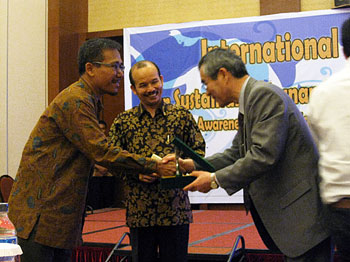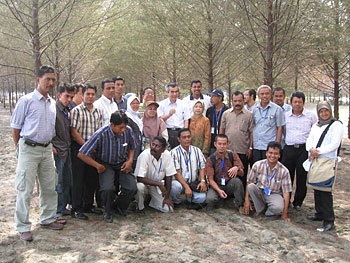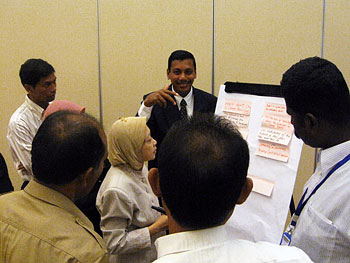Taking the opportunity of the fifth year anniversary of the 2004’s Indian Ocean Tsunami disaster, ICHARM, in cooperation with the Tsunami and Disaster Mitigation Research Center (TDMRC) of Syiah Kuala University, Indonesia carried out an international workshop on sustainable tsunami disaster management. The Workshop was held from 9 to 11 March 2010 at Banda Aceh, Indonesia.
The overall objective is to improve the local community’s capacity on sustainable tsunami disaster management through the development of tsunami disaster awareness and preparedness by using tsunami hazard map and coastal forest implementation.
The participants were selected among local government officials or community leaders whose work is directly related to disaster management. Among the 30 invited participants, five participants were invited from the Indian Ocean region countries, i.e. India, Indonesia, Malaysia, Sri Lanka and Thailand. The rest of participants came from relevant institutions and several tsunami-prone coastal cities in Indonesia.
The Workshop was carried out as a two-and-a half day-program that covers following topics: development of awareness and preparedness; the roles and limitations of coastal forest in tsunami mitigation; planning and design of coastal forest for tsunami mitigation; planning, design and utilization of THM; discussion and group presentation for the enhancement of guideline for THM as well as planning and design of coastal forest for tsunami mitigation; discussion and group presentation on the role of THM in awareness raising; coastal disaster management plan; field orientation and a tour to tsunami historical places in Banda Aceh City.
According to the discussion results, it is concluded that tsunami disasters cause huge casualties because of lack of awareness and protection; the lack of awareness maybe caused by unreliable information and little knowledge and understanding about the risk; tsunami hazard map is potential to communicate reliable information and to develop knowledge and understanding about the risk; integration of tsunami hazard mapping into the whole development program enables effective and sustainable tsunami disaster mitigation; Assuming their development integrates elements such as, environmental sustainability, coastal disaster countermeasures, and local community livelihood, implementation of coastal vegetation belt will contribute to sustainable tsunami disaster mitigation. The workshop also suggested the development of a simpler guideline for planning and design of tsunami-mitigative coastal vegetation belt. Further, the participants agreed to periodically inform to ICHARM about the progress of coastal forest development in their locality.
For more details, see the PWRI Technical Note No. 4179 (PDF 16,314KB).
 Souvenir exchange in the Opening Ceremony; Dr. Shigenobu Tanaka, ICHARM,
Souvenir exchange in the Opening Ceremony; Dr. Shigenobu Tanaka, ICHARM,
Deputy Director (right), the Rector of Syiah Kuala University, Prof.Dr.Darni M.Daud, M.A. (mid),
Vice Director of TDMRC, Dr.Eng.M. Ridha (left)
 Field orientation visit at Casuarina vegetation belt at Alunaga Village, Banda Aceh.
Field orientation visit at Casuarina vegetation belt at Alunaga Village, Banda Aceh.
 A group of Workshop’s participants discussed disaster awareness
A group of Workshop’s participants discussed disaster awareness
development during Group-discussion session. 
